
Garcia is a plant genus of the family Euphorbiaceae and of the monotypic subtribe Garciinae, first described as a genus in 1792. It is native to Central America, Mexico, Colombia, and Venezuela, and also naturalized in some of the West Indies.
- Garcia nutansVahl ex Rohr - Mexico from Sinaloa and San Luis Potosí to Chiapas + Yucatán, Central America, Colombia, Venezuela
- Garcia parvifloraLundell - Chiapas, Tabasco, Veracruz

Cosmos caudatus or king's salad is an annual plant in the genus Cosmos, bearing purple, pink, or white ray florets. It is native to Latin America, and the West Indies, though naturalized in tropical parts of Asia, Africa, and Australia.
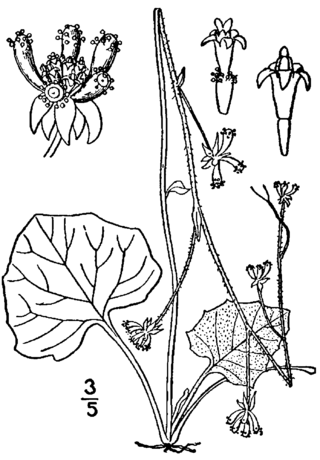
Adenocaulon is a small genus of flowering plants in the family daisy family known generally as trailplants. It was first described in 1829.

Bidens laevis is a species of flowering plant in the daisy family known by the common names larger bur-marigold and smooth beggarticks. It is native to South America, Mexico, and the southern and eastern United States. It grows in wetlands, including estuaries and riverbanks.
Goldmanella is a genus of flowering plants in the daisy family.

Sarcoglottis is a genus of flowering plants from the orchid family, Orchidaceae. It is widespread across much of Latin America from Mexico to Argentina, with one species extending northward into Trinidad and the Windward Islands.

Cyanthillium cinereum is a species of perennial plants in the sunflower family. The species is native to tropical Africa and to tropical Asia and has become naturalized in Australia, Mesoamerica, tropical South America, the West Indies, and the US State of Florida.
Spermacoce glabra, smooth false buttonweed, is a New World species of plants in the coffee family.

Ionopsis utricularioides, the delicate violet orchid, is an epiphytic orchid native to the warmer parts of the Americas. It is reported from Florida, Mexico, Central America, much of the West Indies including the Cayman Islands, South America as far south as Paraguay, and the Galápagos.
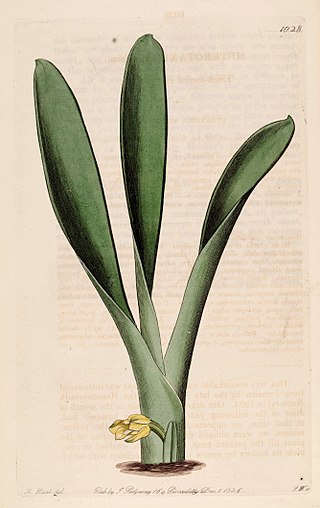
Maxillaria crassifolia, synonyms including Heterotaxis sessilis, is an epiphytic orchid widespread across the West Indies, Central America, southern Mexico, Florida and northern South America. Hidden orchid is a common name.
Diastatea is a genus of plants native to Latin America, mostly in Mexico and Central America but with one species extending southward along the Andes to Argentina.
- Diastatea costaricensisMcVaugh - Guatemala, Honduras, Nicaragua, Costa Rica
- Diastatea expansaMcVaugh - central Mexico
- Diastatea ghiesbreghtii(Kuntze) E.Wimm - southwestern Mexico
- Diastatea micrantha(Kunth) McVaugh - widespread from central Mexico to the Jujuy region of northern Argentina
- Diastatea tenera(A.Gray) McVaugh - southern Mexico and Guatemala
- Diastatea virgataScheidw. - southern Mexico
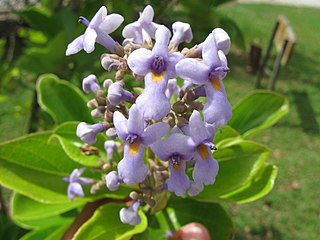
Cornutia is a genus of plants in the family Lamiaceae, first described in 1753. Species in this genus are native to tropical parts of the Western Hemisphere, including southern Mexico, Central America, the West Indies, and northern South America.
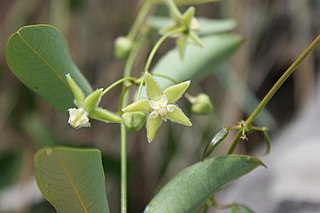
Blepharodon is a genus of plant in the family Apocynaceae, first described as a genus in 1844. They are native primarily to South America, with one species extending into Central America and Mexico.
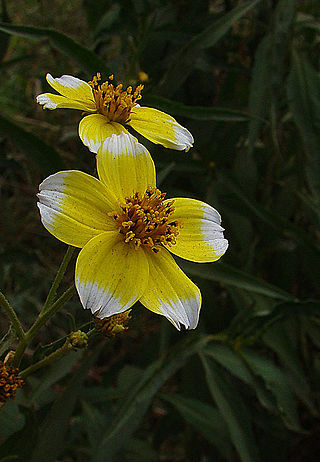
Bidens aurea , the Arizona beggarticks, is a North American species of flowering plant in the family Asteraceae. It is widespread across much of Mexico and found also in Arizona and Guatemala. The species is also naturalized in parts of Europe and South America.
Carminatia tenuiflora (plumeweed) is a species of annual plants in the family Asteraceae. It is native primarily to Mexico, but also the southwestern United States and Central America.

Chromolaena ivifolia called ivy-leaf false thoroughwort, or ivyleaf thoroughwort, is a species of flowering shrub in the family Asteraceae. It is native to North America and South America, from the south-eastern United States to Argentina.
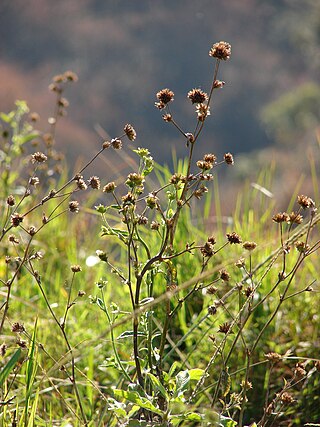
Elephantopus mollis, common names tobacco weed, and soft elephantsfoot, is a tropical species of flowering plant in the family Asteraceae.

Erechtites valerianifolius, common name tropical burnweed is a New World species of plants in the sunflower family. It is native to Mexico, Central America, South America, and the West Indies. It is also naturalized as a weed in much of the tropical Old World.
Tagetes microglossa is a Mesoamerican species of marigold in the family Asteraceae. It grows in Central America, Colombia, and Ecuador, as well as in central and southern Mexico, from Jalisco to Chiapas.
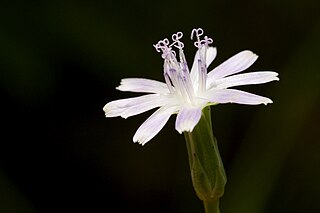
Lactuca graminifolia, the grassleaf lettuce is a North American species of wild lettuce. It grows in Mexico, Central America, Hispaniola, and the southern United States from Arizona to Florida, Virginia and the Carolinas.















